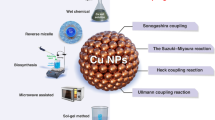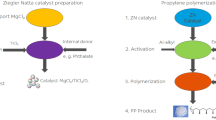Abstract
The present work reports the synthesis of Schiff base ligand Tris[(3-salicylideneimino)ethyl]amine (Sal3Tren) and its copper complex (CuBr(I)/Sal3Tren) for the copolymerization of n-butyl acrylate (n-BA) and 1-octene using atom transfer radical polymerization (ATRP). The structure and morphology of the synthesized Sal3Tren and CuBr(I)/Sal3Tren were confirmed by structure-sensitive techniques, including 1H-13C NMR, FT-IR, PXRD, UV–VIS, TGA, SEM, CV, and CHNS. PXRD revealed the crystallite size of the Sal3Tren ligand and CuBr(I)/Sal3Tren complex to be 70.8 and 32.8 nm, respectively. FT-IR data showed coordination of the azomethine (-CH = N) group to the Cu ion in the CuBr(I)/Sal3Tren complex, which is in good concordance with UV–Vis results. TGA analysis showed the high thermal stability of Sal3Tren ligand up to 282 °C. The CuBr(I)/Sal3Tren catalyst resulted in > 14.5% 1-octene incorporation into the copolymeric chain at the optimized reaction condition [n-BA/1-oct/[CuBr]/[CuBr2]/Sal3Tren/EBiB = 100/100/1/0.1/1/1, Temperature = 100 °C, Time = 48 h]. The kinetic studies revealed a progressive increase of ln (1/1-X) with time, indicating first-order kinetics.
















Similar content being viewed by others
References
Odian G (2004) Principles of polymerization, John Wiley & Sons
Nakamura A, Ito S, Nozaki K (2009) Coordination− insertion copolymerization of fundamental polar monomers. Chem Rev 109(11):5215–5244
Cui D (2020) Studies on homo-and co-polymerizations of polar and non-polar monomers using rare-earth metal catalysts. Acta Polym Sin 51(1):12–29
Chen J, Gao Y, Marks TJ (2020) Early transition metal catalysis for olefin–polar monomer copolymerization. Angew Chem 132(35):14834–14843
Lopez RG, D’agosto F, Boisson C (2007) Synthesis of well-defined polymer architectures by successive catalytic olefin polymerization and living/controlled polymerization reactions. Prog Polym Sci 32(4):419–454
Na Y, Zhang D, Chen C (2017) Modulating polyolefin properties through the incorporation of nitrogen-containing polar monomers. Polym Chem 8(15):2405–2409
Sui X, Hong C, Pang W, Chen C (2017) Unsymmetrical α-diimine palladium catalysts and their properties in olefin (co) polymerization. Mater Chem Front 1(5):967–972
Tan C, Zou C, Chen C (2022) Material properties of functional polyethylenes from transition-metal-catalyzed ethylene–polar monomer copolymerization. Macromolecules 55(6):1910–1922
Tian G, Boone HW, Novak BM (2001) Neutral palladium complexes as catalysts for olefin− methyl acrylate copolymerization: a cautionary tale. Macromolecules 34(22):7656–7663
Tan C, Chen C (2019) Emerging palladium and nickel catalysts for copolymerization of olefins with polar monomers. Angew Chem 131(22):7268–7276
Chen M, Chen C (2018) A versatile ligand platform for palladium-and nickel-catalyzed ethylene copolymerization with polar monomers. Angew Chem Int Ed 57(12):3094–3098
Liu S, Elyashiv S, Sen A (2001) Copper-mediated controlled copolymerization of methyl acrylate with 1-alkenes under mild conditions. J Am Chem Soc 123(50):12738–12739
Venkatesh R, Klumperman B (2004) Olefin copolymerization via controlled radical polymerization: copolymerization of methyl methacrylate and 1-octene. Macromolecules 37(4):1226–1233
Matyjaszewski K, Davis TP (2003) Handbook of radical polymerization, John Wiley & Sons
Braunecker WA, Matyjaszewski K (2008) Erratum to: “Controlled/living radical polymerization: Features, developments and perspectives” [Prog. Polym. Sci. 32 (2007) 93–146]. Prog Polym Sci 1(33):165
Corrigan N, Jung K, Moad G, Hawker CJ, Matyjaszewski K, Boyer C (2020) Reversible-deactivation radical polymerization (Controlled/living radical polymerization): From discovery to materials design and applications. Prog Polym Sci 111:101311
Miao Y-P, Lyu J, Yong H-Y, Sigen A, Gao Y-S, Wang W-X (2019) Controlled polymerization of methyl methacrylate and styrene via Cu (0)-mediated RDRP by selecting the optimal reaction conditions. Chin J Polym Sci 37:591–597
Xu Q, Zhu Y-F, Yuan Z, Tang H-D (2015) Atom transfer radical polymerization of methyl acrylate, methyl methacrylate and styrene in the presence of trolamine as a highly effective promoter. Chin Chem Lett 26(6):773–778
Matyjaszewski K (2018) Advanced materials by atom transfer radical polymerization. Adv Mater 30(23):1706441
Lorandi F, Fantin M, Matyjaszewski K (2022) Atom transfer radical polymerization: a mechanistic perspective. J Am Chem Soc 144(34):15413–15430
Keyes A, Dau H, Matyjaszewski K, Harth E (2022) Tandem living insertion and controlled radical polymerization for polyolefin–polyvinyl block copolymers. Angew Chem 134(10):e202112742
Magenau AJ, Kwak Y, Matyjaszewski K (2010) ATRP of methacrylates utilizing CuIIX2/L and copper wire. Macromolecules 43(23):9682–9689
Davis K (2004) Investigation of the atrp of n-butyl methacrylate using the Cu (I)/N, N, N’N" N"-pentamethyldiethylenetriamine catalyst system. Chin J Polym Sci 22(2):195–204
Tang W, Matyjaszewski K (2006) Effect of ligand structure on activation rate constants in ATRP. Macromolecules 39(15):4953–4959
Wang X-Y, Chen Z-H, Sun X-L, Tang Y (2019) Low temperature effect on ATRP of styrene and substituted styrenes enabled by SaBOX ligand. Polymer 178:121630
Raghunadh V, Baskaran D, Sivaram S (2004) Efficiency of ligands in atom transfer radical polymerization of lauryl methacrylate and block copolymerization with methyl methacrylate. Polymer 45(10):3149–3155
Fang C, Fantin M, Pan X, De Fiebre K, Coote ML, Matyjaszewski K, Liu P (2019) Mechanistically guided predictive models for ligand and initiator effects in copper-catalyzed atom transfer radical polymerization (Cu-ATRP). J Am Chem Soc 141(18):7486–7497
Rorabacher DB (2004) Electron transfer by copper centers. Chem Rev 104(2):651–698
Haddleton DM, Kukulj D, Duncalf DJ, Heming AM, Shooter AJ (1998) Low-temperature living “radical” polymerization (atom transfer polymerization) of methyl methacrylate mediated by copper (I) N-alkyl-2-pyridylmethanimine complexes. Macromolecules 31(16):5201–5205
Singh A, Barman P (2021) Recent advances in schiff base ruthenium metal complexes: synthesis and applications. Top Curr Chem 379:1–71
Xu X, Hong M, Bao C, Wang Y, Chen J, Li D, Wang T, Zhang Q (2021) A Schiff base ligand for photoinduced atom transfer radical polymerization. Polym Chem 12(12):1797–1805
Xu X, Peng B, Hong M, Wang T, Fan L, Bao C, Zhang Q (2022) Photo-induced atom transfer radical polymerization of styrene using a highly active claw-type Schiff-base ligand. Eur Polymer J 172:111201
Kannappan R, Tanase S, Mutikainen I, Turpeinen U, Reedijk J (2006) Low-spin iron (III) Schiff-base complexes with symmetric hexadentate ligands: Synthesis, crystal structure, spectroscopic and magnetic properties. Polyhedron 25(7):1646–1654
Matyjaszewski K, Tsarevsky NV (2014) Macromolecular engineering by atom transfer radical polymerization. J Am Chem Soc 136(18):6513–6533
Keypour H, Salehzadeh S, Parish R (2002) Synthesis of two potentially heptadentate (N4O3) schiff-base ligands derived from condensation of tris (3-aminopropyl)-amine and salicylaldehyde or 4-hydroxysalicylaldehyde. nickel (ii) and copper (ii) complexes of the former ligand. Molecules 7(2):140–144
Neelakantan M, Rusalraj F, Dharmaraja J, Johnsonraja S, Jeyakumar T, Pillai MS (2008) Spectral characterization, cyclic voltammetry, morphology, biological activities and DNA cleaving studies of amino acid Schiff base metal (II) complexes. Spectrochim Acta Part A Mol Biomol Spectrosc 71(4):1599–1609
Warad D, Satish C, Kulkarni V, Bajgur CS (2000) Synthesis, structure and reactivity of zirconium (IV), vanadium (IV), cobalt (II), nickel (II) and copper (II) complexes derived from carbohydrazide schiff base ligands, Indian Journal of Chemistry 39(4):415–420
Mishra DK, Singha UK, Das A, Dutta S, Kar P, Chakraborty A, Sen A, Sinha B, Binding DNA (2018) amelioration of oxidative stress, and molecular docking study of Zn (II) metal complex of a new Schiff base ligand. J Coord Chem 71(14):2165–2182
Saikia M, Baruah U, Borphukan S, Saikia PJ, Saikia BK, Baruah SD (2019) Controlled copolymerization of 1-octene and butyl methacrylate via RAFT and their nonisothermal model-free thermokinetic decomposition study. J Polym Sci Part A Polym Chem 57(20):2093–2103
Kaur S, Singh G, Gupta VK (2009) Solid acid clay mediated copolymerization of methyl acrylate and 1-octene: 2D NMR substantiation of predominant alternating comonomer sequence. J Polym Sci Part A Polym Chem 47(8):2156–2162
Dubey R, Baranwal P, Dwivedi S, Tripathi U (2011) Synthesis and spectral studies of some new dimeric [(μ-Cl) 2M2 (L) 2· x THF][M= Zn (II) and Hg (II)] complexes containing Schiff-base ligands. J Coord Chem 64(15):2649–2657
Hou X, Jones B, Meyers R (2000) Encyclopedia of analytical chemistry. Cyclic activation analysis. Wiley, Chichester, pp 12447–12459
Palanimurugan A, Kulandaisamy A (2018) Synthesis, characterization, antimicrobial and anticancer activities of 14-membered macrocyclic schiff base metal complexes. Asian J Chem 30(6)
Lever AP (1984) Inorganic electronic spectroscopy. Stud Phys Theor Chem 33
Tümer M, Köksal H, Serin S, Dig¯ rak M (1999) Antimicrobial activity studies of mononuclear and binuclear mixed-ligand copper (II) complexes derived from Schiff base ligands and 1, 10-phenanthroline. Trans Met Chem 24(1):13–17
Garnier-Suillerot A, Albertini J-P, Collet A, Faury L, Pastor J-M, Tosi L (1981) Spectrophotometric studies of the copper (II)–D-o-tyrosine complex. Assignment of the 330-nm dichroic band in copper (II) and iron (III) transferrins. J Chem Soc Dalton Trans (12):2544–2549
Sanatkar TH, Khorshidi A, Sohouli E, Janczak J (2020) Synthesis, crystal structure, and characterization of two Cu (II) and Ni (II) complexes of a tetradentate N2O2 Schiff base ligand and their application in fabrication of a hydrazine electrochemical sensor. Inorg Chim Acta 506:119537
Xu X, Bao C, Hong M, Li D, Zhang Q (2020) A tripodal heptadentate Schiff base as an active ligand for atom transfer radical polymerization. Polym Chem 11(39):6356–6364
Raman N, Jeyamurugan T (2009) Synthesis, characterization, and DNA interaction of mononuclear copper (II) and zinc (II) complexes having a hard-soft NS donor ligand. J Coord Chem 62(14):2375–2387
Sridhar G, Mohammed Bilal I, Easwaramoorthy D, Kutti Rani S, Siva Kumar B, Manohar CS (2017) Synthesis, characterization and antimicrobial activities of copper, nickel, cobalt, chromium complexes derived from (Z)-4-Fluoro-N-(2, 7-dimethylhept-6-enylidene) benzenamine. J Braz Chem Soc 28:756–767
Fu Z, Fan Y, Fan Z (2011) Temperature-structure dependence of poly (1-octene-co-t-butyl acrylate) prepared by conventional free radical polymerization. Iran Polym J 20(3):223–235
Jozaghkar MR, Ziaee F, Ardakani HRH, Ashenagar S, Jalilian M (2019) Kinetics of high-temperature bulk thermal polymerization of methyl styrene. Iran J Polym Sci Technol (Persian) 32(3):227–240
de la Fuente JL, Fernández-Sanz M, Fernández-García M, Madruga EL (2001) Solvent effects on the synthesis of poly (methyl methacrylate) by atom-transfer radical polymerization (ATRP). Macromol Chem Phys 202(12):2565–2571
Braunecker WA, Tsarevsky NV, Gennaro A, Matyjaszewski K (2009) Thermodynamic components of the atom transfer radical polymerization equilibrium: quantifying solvent effects. Macromolecules 42(17):6348–6360
Omar M, Mohamed GG, Ibrahim AA (2009) Spectroscopic characterization of metal complexes of novel Schiff base. Synthesis, thermal and biological activity studies. Spectrochim Acta Part A Mol Biomol Spectrosc 73(2):358–369
Böhme U, Günther B (2007) Five and six-coordinate silicon complexes with an O, N, O′-chelating ligand derived from o-hydroxyacetophenone–N-(2-hydroxyethyl) imine. Inorg Chem Commun 10(4):482–484
Bryaskova R, Willet N, Degée P, Dubois P, Jérôme R, Detrembleur C (2007) Copolymerization of vinyl acetate with 1-octene and ethylene by cobalt-mediated radical polymerization. J Polym Sci Part A Polym Chem 45(12):2532–2542
Tanaka K, Matyjaszewski K (2007) Controlled copolymerization of n-butyl acrylate with nonpolar 1-alkenes using activators regenerated by electron transfer for atom-transfer radical polymerization. Macromolecules 40(15):5255–5260
Kavitha A, Singh AK, Singha NK (2011) Copolymerization of styrene with an α-olefin via atom transfer radical polymerization. Polym Int 60(7):1039–1046
Acknowledgements
The authors are highly grateful to the Director, CSIR-IIP, Dehradun, for his kind permission to publish these results. BS and SS are grateful to the CSIR-New Delhi for financial assistance in a research fellowship. AV acknowledges Department of Science and Technology (DST) for providing INSPIRE research fellowship. AcSIR-New Delhi is acknowledged for the Ph.D. registration. The authors are thankful to ASD, CSIR-IIP for their support in carrying out the analysis and characterizations.
Funding
This research did not receive any specific grant from funding agencies in the public, commercial, or not-for-profit sectors.
Author information
Authors and Affiliations
Contributions
Umesh Kumar: Supervision, Conceptualization, Methodology, Data Review and Interpretation Bhawna Sharma: Experimental Work, Writing-original draft, Visualization, Methodology, Validation. Akash Verma: Experimental Work, Data review and Editing. Swati: Experimental Work, Data review and Editing.
Corresponding author
Ethics declarations
Conflicts of interests
The authors declare that they have no known competing financial interests or personal relationships that could have appeared to influence the work reported in this paper.
Additional information
Publisher's Note
Springer Nature remains neutral with regard to jurisdictional claims in published maps and institutional affiliations.
Supplementary Information
Below is the link to the electronic supplementary material.
Rights and permissions
Springer Nature or its licensor (e.g. a society or other partner) holds exclusive rights to this article under a publishing agreement with the author(s) or other rightsholder(s); author self-archiving of the accepted manuscript version of this article is solely governed by the terms of such publishing agreement and applicable law.
About this article
Cite this article
Sharma, B., Verma, A., Saini, S. et al. Tris[(3-salicylideneimino)ethyl]amine an effective ATRP ligand for the copolymerization of n-butyl acrylate and 1-octene. J Polym Res 30, 126 (2023). https://doi.org/10.1007/s10965-023-03493-0
Received:
Accepted:
Published:
DOI: https://doi.org/10.1007/s10965-023-03493-0




